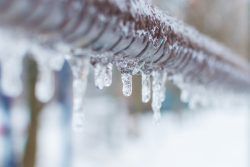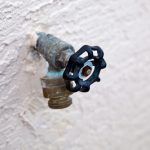How To Check For Frozen Pipe Damage?
 How To Check For Frozen Pipe Damage?
How To Check For Frozen Pipe Damage?
Winter comes with its own set of problems, and one of the most common ones is frozen pipes. Frozen pipes can quickly turn into a plumbing disaster if not attended to promptly. They may cause water damage and lead to expensive repairs, especially if you fail to detect them early. Therefore, it’s essential to check for frozen pipe damage as soon as possible to prevent further damage.
Here’s a comprehensive guide on how to check for frozen pipe damage, courtesy of our Colorado Springs plumbers :
1. Look for signs of water damage
Water damage is the first noticeable sign of possible frozen pipe damage. If you notice wet patches on your walls, floors, or ceilings, or there’s a bad odor in your home, it could be a sign of a burst pipe. Shut off your main water supply immediately to prevent further damage and call a plumber to fix the problem.
2. Check for low water pressure
Low water pressure may be an indication of frozen pipes. Turn on all the faucets in your home and check if the water pressure is slow or erratic. If so, it’s advisable to call a licensed plumber to assess the problem. They’ll identify the location of the frozen pipes, thaw them, and fix any resulting damage.
3. Inspect the exposed pipes
It’s easier to check for frozen pipe damage on exposed pipes. Inspect the exposed pipes in your basement, crawl spaces, and attic for any visible signs of damage. Frozen pipes have visible cracks or splits on their surfaces. If you notice any cracks or splits, call a plumber immediately to prevent further damage.
4. Check for stagnant water
Stagnant water is another sign of frozen pipe damage. Check the areas with exposed pipes for water that’s not flowing. If water is not flowing, it could be due to freezing in the pipes. This could cause pressure to build up, leading to possible burst pipes. Contact a professional, licensed plumber immediately to assess and fix the problem.
5. Use an infrared thermometer
Infrared thermometers are great tools for checking for frozen pipe damage. They work by measuring the surface temperature of objects. Check for changes in temperature along the pipes’ length using the infrared thermometer. A sudden drop in temperature indicates a blockage due to freezing, which can cause pipe bursts.
6. Listen for strange noises
Strange noises, such as creaking or squeaking, can be indicative of frozen pipe damage. The sound is produced as the frozen water in the pipes expands, thereby increasing the pressure within the pipes. You may also hear a cracking or explosion sound when the pressure becomes too much, resulting in a burst pipe. If you hear any of these sounds, call a plumber immediately.
7. Inspect concealed pipes
Many of the pipes in our homes are concealed behind walls and ceilings, making it difficult to check for any damage. But if you suspect frozen pipe damage, check for damp patches on ceilings and walls, musty smells, and peeling paint. These are usually signs of water damage that require extensive plumbing repairs .
8. Turn on all your water appliances
Turn on all your water appliances, including the dishwasher and washing machine, and check for any abnormal sounds. If you notice any odd noises or low water pressure, it could be due to frozen pipes. You should call a licensed plumber who can quickly fix any damage caused by the frozen pipes.
Conclusion
Checking for frozen pipe damage is essential to prevent further damage and reduce repair costs. Be on the lookout for any signs of water damage, low water pressure, stagnant water, cracks or splits on exposed pipes, temperature changes along the pipes’ length, strange noises, and damp patches on walls and ceilings. If you notice any of these signs, call a licensed plumber to assess the problem. You can also prevent frozen pipe damage by insulating your pipes, keeping the heat on, and letting your faucets drip. Avoiding frozen pipe damage can save you countless hours of stress, time, and money.




